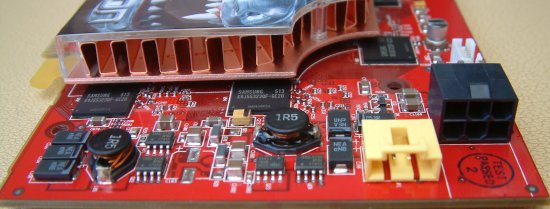Connect3D X800 GTO 256MB
There's various ways an ATI AIB partner can go about the business of releasing an X800 GTO card. With basic GTO specs. encompassing a 12-pipe (three-quad) fragment processor architecture running at 400MHz, the choice of not-quite-right cores (and PCBs) is quite diverse. AIBs can opt for R480 core, which is currently ATI's high-end SKU, and found on X850 PRO/XT/XT PE models. These were initially designed to run with 16 pipelines active, so choosing the R480, as SAPPHIRE has done, will generally result in highly-overclockable X800 GTOs, although ATI has ensured that you won't be able to modify these into a full 16-pipe card via a simple BIOS flash. You'll need a Radeon X800 GTO² 256MB card for that.AIBs, if given the choice, can also opt for R423 and R430 cores that run with at least three quads active. These should be a touch cheaper for a partner to buy in bulk. The R423, the PCI-Express version of the X800-series, should also overclock well. R430, which is a PCI-Express-only core, is found on ATI's X800 XL and X800 cards. In short, all an AIB partner needs to know is whether the supplied core will function with 12 active, locked pipelines and with core speeds of 400MHz. Anything above that is a bonus.

Take a look at the Connect3D Radeon X800 GTO 256MB card and see if it reminds you of anything. Eagle-eyed readers with relatively long memories will recall that Connect3D's X800 GTO 256MB card is identical, in appearance at least, to ATI's reference X800 PRO and X800 XT PCI-Express cards. That would suggest Connect3D is using R423-based cores here.

The cooler comes away by removing three screws on the underside. The copper-based heatsink is more than capable of cooling a full 16-pipe X800 XT that's clocked in at 500MHz, so we have no cooling worries here. The off-centre fan is virtually inaudible when the card is in 2D mode, and it takes prolonged 3D load, in warm conditions, to hear it above a quiet system's background noise. Whipping off the cooler leaves a bare-looking PCB with 4 256Mbit GDDR3 RAM chips on either side.

Our suspicions hold true. Connect3D is using an X800 PCI-Express core that's a.k.a. R423. Chances are that it will scale past the GTO's 400MHz engine clock and beyond an X800 PRO's 475MHz default speed.

The front of the card also carries on the X800 PRO/XT theme by having an auxillary 6-pin power connector. The Radeon X800 GTO's relatively slow core speed and PCI-Express interface doesn't require additional power but the basic R423 PCB has always included it. An educated guess would surmise that Connect3D has bought in a chunk of X800-class cores and associated PCBs that didn't quite make it to X800 PRO/XT grade. Note how the off-centre fan blows air across the copper heatsink and out of the front. That doesn't do too much for case cooling.

VGA and DVI connections are the usual fare. However, this time, the S-Video port in the middle is used for both video-in and video-out (VIVO).

The ASIC on the right-hand side is none otherg than ATI's much-used Rage Theater. It's no Rage Theater Pro 550 and doesn't benefit from the features inherent to Avivo, but it's a low-cost method of adding value to an AIB partner card.

256MBytes of Samsung's ubiquitous GC-20 GDDR3, made up of 8 256MBit chips, is to be expected on a card whos default memory clock is 980MHz. Connect3D's used ATI's R423 as a base to release its Radeon X800 GTO 256MB card. Online retail pricing of £117.99 makes it a financially competitive 'GTO, too.

X800 PRO or X800 GTO? It's the former that's been reclocked and renamed into the latter. ATI Tool confirms the card's origins.









